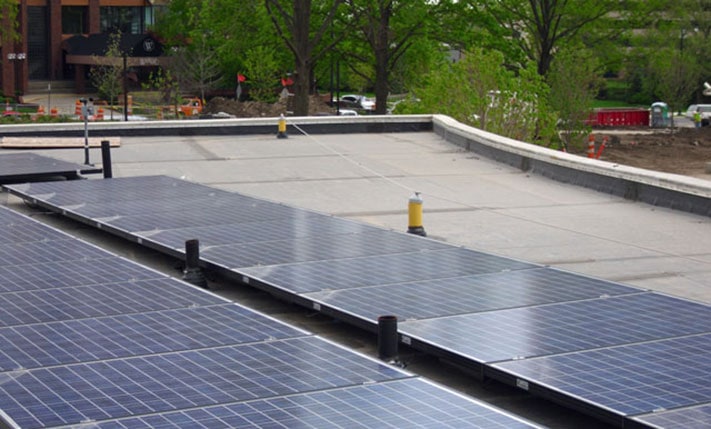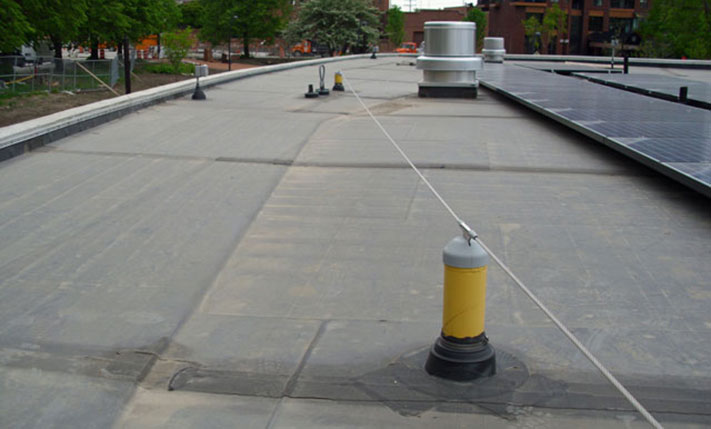Fall Protection Systems for the Solar Energy Industry
Interest in renewable energy has led to the installation of rooftop mounted solar energy panels that pose potential fall hazards to maintenance personnel. Providing safe rooftop access to remove the dust and particulate that reduces the efficiency of your solar energy panels requires a comprehensive fall prevention strategy, which includes the proper mix of fall protection equipment, a descent and rescue plan, personnel training, and partnering with a fall protection company that appreciates the unique nature of the potential fall hazards associated with the solar energy industry.

Solar Energy

Solar Energy
Whether you need to retrofit fall protection solutions for an existing panel system or you are in the initial design phase of a project, our team of engineers and safety specialists can keep maintenance personnel safe while ensuring full compliance with OSHA fall protection regulations. Don’t let a lack of fall protection derail your plans to provide renewable energy–contact Diversified Fall Protection to discuss your safety needs today.
We are a complete turnkey provider of fall protection systems designed for the solar energy industry and have the years of design and installation experience in this market sector. Contact us for expert assistance with your fall arrest, fall restraint and fall protection safety requirements.
Fall Protection Solutions
-
Horizontal Lifelines
View Horizontal Lifelines -
Rescue and Descent Systems
View Rescue and Descent Systems -
Fall Protection Anchors
View Fall Protection Anchors -
Tip-Over Single Point Anchors
View Tip-Over Single Point Anchors
Design Considerations
Solar Energy Fall Protection Design Considerations
Although some solar energy farms are ground based systems, rooftop mounted solar panels pose the most significant dangers to worker safety. To maximize efficiency, the footprint of a typical rooftop solar energy installation tends to be quite large, leaving little space between the end of each panel and the leading edge of the roof. The support structure of the solar panel must be assessed to determine if the framing members are adequate to accommodate the installation of a fall protection system. In instances where a fall protection system cannot be attached to the solar panel support structure, care must be taken to consider rooftop construction materials (e.g., standing seam metal, rubber membrane).
After the structural integrity of your rooftop mounted solar energy system is assessed, a horizontal lifeline is either attached to the system’s supporting members or tip-over posts are used to create a perimeter based lifeline system. Tip-over systems must be specified and installed to match the physical characteristics of your roof. Whether your roof is constructed from concrete, sheet metal, standing seam metal, or rubber membrane, our field engineers and installation specialists can recommend and install a tip-over, perimeter style horizontal lifeline system that will keep personnel safe as they service your solar energy panels. Some fall protection systems for solar installations may also utilize rigid track systems. Although this is a relatively new market, Diversified Fall Protection has years of experience installing OSHA compliant fall protection systems for the solar energy market including:
- Horizontal Lifelines
- Rescue and Descent
- Rigid Systems
- Single Point Anchors
OSHA Regulations
- HLL/VLL
- 1926.502(d)
'Personal fall arrest systems.' Personal fall arrest systems and their use shall comply with the provisions set forth below. Effective January 1, 1998, body belts are not acceptable as part of a personal fall arrest system. Note: The use of a body belt in a positioning device system is acceptable and is regulated under paragraph (e) of this section. - 1926.502(d)(8)
Horizontal lifelines shall be designed, installed, and used, under the supervision of a qualified person, as part of a complete personal fall arrest system, which maintains a safety factor of at least two. - 1926.502(d)(9)
Lanyards and vertical lifelines shall have a minimum breaking strength of 5,000 pounds (22.2 kN). - 1926.502(d)(10) 1926.502(d)(10)(i)
Except as provided in paragraph (d)(10)(ii) of this section, when vertical lifelines are used, each employee shall be attached to a separate lifeline. - 1926.502(d)(11)
Lifelines shall be protected against being cut or abraded. - 1926.502(d)(12)
Self-retracting lifelines and lanyards which automatically limit free fall distance to 2 feet (0.61 m) or less shall be capable of sustaining a minimum tensile load of 3,000 pounds (13.3 kN) applied to the device with the lifeline or lanyard in the fully extended position. - 1926.502(d)(13)
Self-retracting lifelines and lanyards which do not limit free fall distance to 2 feet (0.61 m) or less, ripstitch lanyards, and tearing and deforming lanyards shall be capable of sustaining a minimum tensile load of 5,000 pounds (22.2 kN) applied to the device with the lifeline or lanyard in the fully extended position.
- 1926.502(d)
- Personal Fall Arrest Systems
- 1926.502(d)
'Personal fall arrest systems.' Personal fall arrest systems and their use shall comply with the provisions set forth below. Effective January 1, 1998, body belts are not acceptable as part of a personal fall arrest system. Note: The use of a body belt in a positioning device system is acceptable and is regulated under paragraph (e) of this section. - 1926.502(d)(16)
Personal fall arrest systems, when stopping a fall, shall: - 1926.502(d)(16)(i)
limit maximum arresting force on an employee to 900 pounds (4 kN) when used with a body belt; - 1926.502(d)(16)(ii)
limit maximum arresting force on an employee to 1,800 pounds (8 kN) when used with a body harness; - 1926.502(d)(16)(iii)
be rigged such that an employee can neither free fall more than 6 feet (1.8 m), nor contact any lower level; - 1926.502(d)(16)(iv)
bring an employee to a complete stop and limit maximum deceleration distance an employee travels to 3.5 feet (1.07 m); and, - 1926.502(d)(16)(v)
have sufficient strength to withstand twice the potential impact energy of an employee free falling a distance of 6 feet (1.8 m), or the free fall distance permitted by the system, whichever is less.
- 1926.502(d)
- Ladders
- 1926.1053(a)(18)
Fixed ladders shall be provided with cages, wells, ladder safety devices, or self-retracting lifelines where the length of climb is less than 24 feet (7.3 m) but the top of the ladder is at a distance greater than 24 feet (7.3 m) above lower levels. - 1926.1053(a)(19)
Where the total length of a climb equals or exceeds 24 feet (7.3 m), fixed ladders shall be equipped with one of the following: - 1926.1053(a)(19)(i)
Ladder safety devices; or - 1926.1053(a)(19)(ii)
Self-retracting lifelines, and rest platforms at intervals not to exceed 150 feet (45.7 m); or - 1926.1053(a)(19)(iii)
A cage or well, and multiple ladder sections, each ladder section not to exceed 50 feet (15.2 m) in length. Ladder sections shall be offset from adjacent sections, and landing platforms shall be provided at maximum intervals of 50 feet (15.2 m).
- 1926.1053(a)(18)
Talk to a fall protection specialist
Tell us about your fall protection needs, and we’ll configure a system that rises to your challenges.

